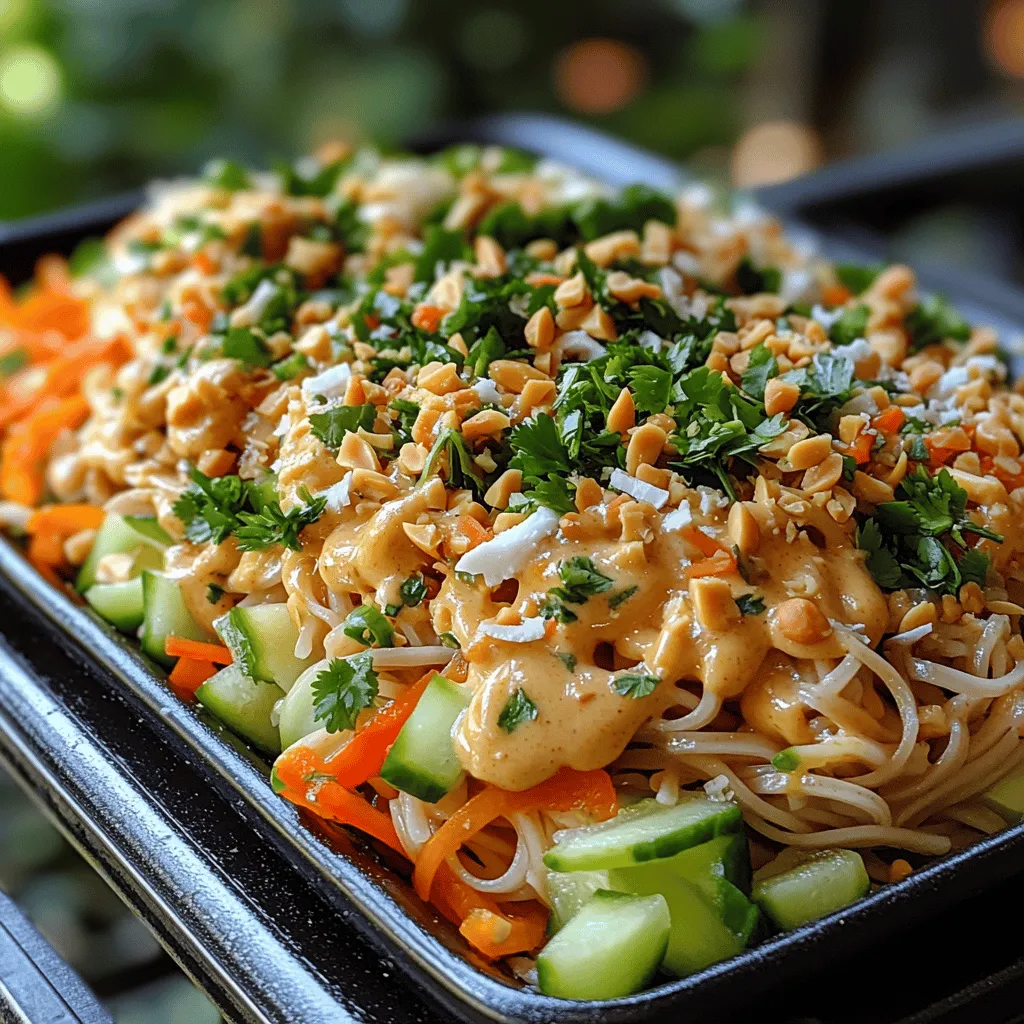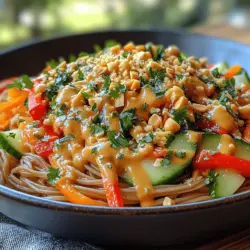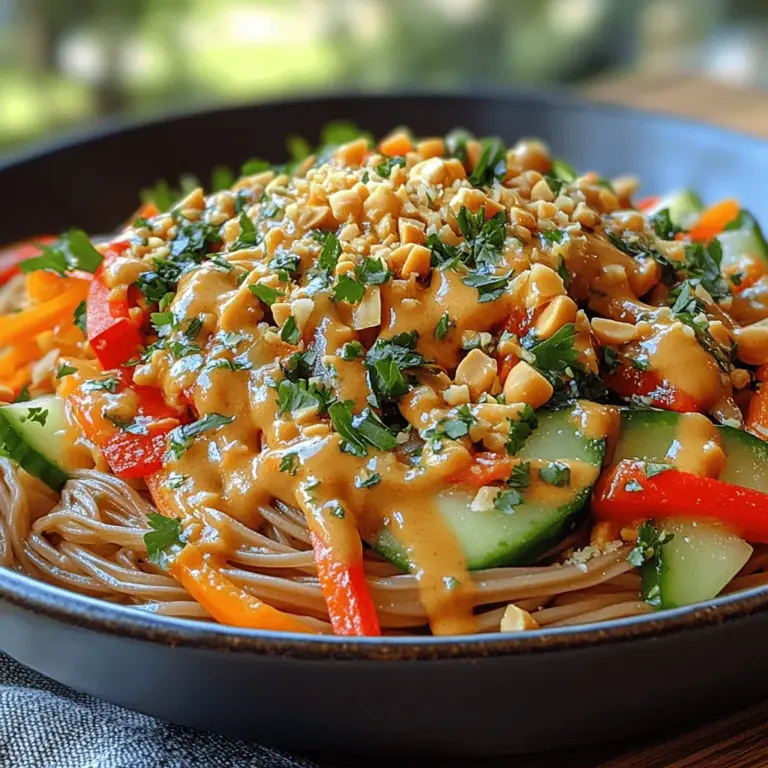Chilled Coconut Thai Peanut Noodles: A Refreshing Delight
When it comes to light, vibrant meals that burst with flavor, Chilled Coconut Thai Peanut Noodles stand out as a perfect choice. This dish captures the essence of Thai cuisine, offering a delightful combination of fresh ingredients, creamy peanut sauce, and a satisfying crunch. Ideal for warm weather or light lunches, these noodles provide a refreshing escape from heavier fare, making them a favorite among food enthusiasts and health-conscious diners alike.
The appeal of Chilled Coconut Thai Peanut Noodles lies in their remarkable balance of flavors and textures. The nutty richness of peanut butter intertwines with the creaminess of coconut milk, while fresh vegetables add a crisp contrast that invigorates the palate. Each bite is a harmonious blend of sweet, savory, and umami notes, complemented by the zing of lime juice and the aromatic kick of garlic. This delightful medley not only tantalizes the taste buds but also nourishes the body, making it a wholesome meal option.
One of the standout features of this dish is its health benefits. Packed with fresh vegetables like carrots, cucumbers, bell peppers, red cabbage, green onions, and cilantro, Chilled Coconut Thai Peanut Noodles are rich in vitamins, minerals, and antioxidants. These colorful additions not only enhance the visual appeal of the dish but also contribute to its nutritional profile. Furthermore, the healthy fats from peanuts provide energy and support heart health, while the use of coconut milk adds a dose of medium-chain triglycerides, known for their potential health benefits.
Understanding the Ingredients
To create a truly memorable plate of Chilled Coconut Thai Peanut Noodles, it’s essential to understand the key components that come together in this recipe. The choice of noodles is a significant factor, as it sets the stage for the entire dish. Soba noodles, made from buckwheat, offer a nutty flavor and are a gluten-free option, while rice noodles are another popular choice, known for their light texture and ability to soak up flavors. Both types provide a delicious foundation for the noodle dish, but soba noodles have the added benefit of being higher in protein and fiber.
Fresh vegetables play a crucial role in both the aesthetics and health benefits of this meal. Carrots offer a sweet crunch, cucumbers provide refreshing juiciness, bell peppers add vibrant color and crunch, red cabbage brings a satisfying texture, and green onions and cilantro contribute zesty freshness. Each vegetable is a powerhouse of nutrients, making this dish not only delicious but also a great way to incorporate a variety of produce into your diet.
Peanuts are the star ingredient in the dish, adding a distinctive flavor and delightful crunch. Rich in healthy fats, protein, and fiber, they contribute to satiety and overall health. When making the dish, the quality of your peanuts can make a notable difference. Opt for natural, unsalted varieties to ensure the best flavor and health benefits.
The peanut sauce is another essential element that brings the dish to life. A good peanut sauce is creamy and rich, with just the right balance of flavors. Creamy peanut butter serves as the base, and choosing the right type can enhance your sauce. Natural peanut butter, made from just peanuts (and perhaps a pinch of salt), is ideal for a smooth texture and authentic flavor.
Coconut milk not only adds creaminess but also enhances the overall flavor profile of the sauce, creating a luscious coating for the noodles. The addition of lime juice brings a bright acidity that cuts through the richness, while garlic adds depth and aroma. Together, these ingredients create a peanut sauce that is both tantalizing and satisfying.
Preparation Steps Explained
Now that we’ve covered the foundational elements of Chilled Coconut Thai Peanut Noodles, let’s delve into the preparation steps. This dish is all about multitasking and efficient time management in the kitchen, so having a clear plan is essential.
Cooking the Noodles:
Begin by bringing a large pot of water to a boil. If you’re using soba noodles, follow the package instructions for cooking times, which usually call for around 4 to 6 minutes. The goal is to cook them until al dente, ensuring they retain a slight bite. Once cooked, promptly drain the noodles and rinse them under cold water. This step is crucial as it stops the cooking process and prevents the noodles from becoming sticky. Rinsing also helps to cool the noodles, making them ready for the chilled aspect of the dish.
Preparing the Vegetables:
While the noodles are cooking, take the time to prepare your fresh vegetables. The presentation of this dish is just as important as its taste, so aim for visually appealing cuts. For carrots, use a julienne peeler or a sharp knife to create thin strips. Cucumbers can be cut into thin rounds or diced, while bell peppers can be sliced into thin strips. Red cabbage should be shredded finely to ensure it mixes well with the other ingredients. Finally, chop the green onions and cilantro, setting aside a little for garnish. These fresh toppings not only add flavor but also enhance the visual appeal of the final dish.
Multitasking for Efficiency:
As you prepare each component, it’s helpful to multitask. While the noodles are cooking, you can simultaneously chop the vegetables to save time. Organizing your workspace and having all your ingredients prepped and ready will streamline the cooking process. Once the noodles and vegetables are ready, it’s time to turn your attention to the peanut sauce.
Making the Peanut Sauce
Creating the peanut sauce is a straightforward but rewarding process. Begin by gathering your ingredients: creamy peanut butter, coconut milk, lime juice, minced garlic, and a pinch of salt.
In a mixing bowl, combine the peanut butter and coconut milk, whisking until well blended. The goal is to achieve a creamy consistency that can easily coat the noodles. You can adjust the thickness of the sauce by adding more coconut milk if necessary or by using less for a richer sauce. Next, add lime juice to taste, which will brighten the sauce and balance the richness of the peanut butter. Finally, stir in the minced garlic; this ingredient will infuse the sauce with savory depth.
Taste your sauce and adjust the flavors as needed. If you prefer a bit of sweetness, consider adding a drizzle of honey or maple syrup. On the other hand, if you like a spicier kick, a dash of sriracha can elevate the flavors to new heights. The beauty of making your own sauce is the ability to customize it to your liking.
With all components prepared, you are now ready to bring together the Chilled Coconut Thai Peanut Noodles. The next phase will involve combining everything into a delightful dish that beautifully showcases the vibrant flavors and textures you’ve created.

Variations
Substitutions for Dietary Restrictions
When it comes to making Chilled Coconut Thai Peanut Noodles, flexibility is key, especially when accommodating dietary restrictions. If you need to create a nut-free version, consider using sunflower seed butter or tahini in place of peanut butter. These alternatives maintain a creamy texture while offering a unique flavor profile. For those who need to watch their sodium intake, low-sodium soy sauce or tamari is an excellent substitution. It allows you to enjoy the umami flavor without overwhelming your dish with salt.
Additionally, if you’re looking for gluten-free options, swap traditional noodles with rice noodles or gluten-free pasta. This maintains the dish’s essence while catering to different dietary needs.
Customizing Heat Levels with Red Pepper Flakes
One of the standout features of this dish is its ability to cater to various palates, particularly when it comes to heat. If you enjoy a spicy kick, feel free to add red pepper flakes to your sauce or sprinkle them over the finished dish. Start with a small amount and adjust according to your taste preference. The beauty of this recipe lies in its adaptability—whether you prefer a mild flavor or crave a fiery kick, you can easily customize it to suit your preferences.
Combining Ingredients for Maximum Flavor
Techniques for Mixing Noodles and Veggies with the Sauce
Once your noodles are cooked and cooled, it’s time to combine them with the vegetables and sauce. Begin by placing the chilled noodles in a large mixing bowl. Add the prepped vegetables, making sure to include a colorful assortment like bell peppers, cucumbers, and carrots for visual appeal and texture.
Pour the coconut peanut sauce over the mixture, ensuring an even distribution. Use a pair of tongs or your hands (with clean hands, of course) to gently toss the noodles and veggies together. This technique is crucial; it allows the sauce to coat each strand of noodle without breaking them apart or bruising the vegetables.
Importance of Gentle Tossing to Maintain the Integrity of the Vegetables
Gentle tossing is essential in this step. Overmixing can lead to mushy vegetables, which detracts from the fresh crunch you want to achieve. Aim for a light touch, and if necessary, do this in batches to ensure that each ingredient gets the attention it deserves. The goal is to create a harmonious blend of flavors while preserving the vibrant textures of the fresh produce.
How to Ensure Even Coating of the Sauce
To ensure that every bite is bursting with flavor, it’s important to coat the noodles evenly with the sauce. After tossing, if you find that some areas are lacking sauce, drizzle a little more over the top and toss again lightly. You can also reserve a small amount of sauce to drizzle over the noodles just before serving, enhancing both flavor and appearance.
The Chilling Process
Why Chilling the Dish is Essential
Chilling your Chilled Coconut Thai Peanut Noodles is not just a suggestion—it’s a vital step that enhances the overall experience. As the dish sits in the refrigerator, the flavors meld together, creating a more cohesive and delicious taste. The cooling process allows the sauce to penetrate the noodles and vegetables, ensuring that every bite is infused with the vibrant flavors of coconut, peanut, and fresh herbs.
How Chilling Enhances Flavor Melding and Texture
Beyond flavor enhancement, chilling also affects the texture of the dish. Cold noodles are refreshing, especially in warmer weather, and the crispness of the vegetables is maintained, providing a satisfying crunch with each bite. The contrast between the creamy sauce and the cold, crunchy veggies is what makes this dish so enjoyable.
Recommended Chilling Times for Best Results
For optimal flavor, refrigerate the assembled noodles for at least 30 minutes. If you have time, letting it chill for an hour or even longer will give the flavors even more time to meld. Just be sure to cover the bowl with plastic wrap or a lid to keep the noodles from drying out.
Serving Suggestions
Ideas for Garnishing to Elevate Presentation
Presentation is key when it comes to enjoying your Chilled Coconut Thai Peanut Noodles. Garnish with a sprinkle of chopped peanuts for extra crunch, and fresh herbs such as cilantro or Thai basil for an aromatic touch. A few lime wedges on the side not only add a pop of color but also offer a zesty brightness when squeezed over the dish just before eating.
Importance of Color Contrast and Texture in Plating
When plating, focus on color contrast and texture to make the dish visually appealing. Use a wide, shallow bowl to showcase the vibrant colors of the noodles and vegetables. Layer the ingredients artfully, allowing the bright colors of the bell peppers, greens, and noodles to shine through. A well-plated dish not only looks appetizing but also enhances the overall dining experience.
Pairing Suggestions
To make your meal even more satisfying, consider pairing your Chilled Coconut Thai Peanut Noodles with grilled proteins such as chicken, shrimp, or tofu. This not only adds a protein component but also a smoky flavor that complements the creamy peanut sauce beautifully. A light salad with a citrus vinaigrette can also serve as a refreshing side, balancing the richness of the noodles.
Nutritional Analysis
Breakdown of the Nutritional Benefits of the Dish
Chilled Coconut Thai Peanut Noodles are not just delicious; they also offer a range of nutritional benefits. The primary ingredients provide a good balance of macronutrients, making it a well-rounded meal option.
Macronutrient Content: Carbohydrates, Proteins, and Fats
The noodles serve as a great source of carbohydrates, providing the energy needed to fuel your day. The peanut butter adds healthy fats and protein, which are essential for muscle repair and overall health. The vegetables contribute to the fiber content, promoting digestive health and fullness.
Vitamins and Minerals from the Vegetables
The colorful array of vegetables not only enhances the flavor and visual appeal but also provides essential vitamins and minerals. Bell peppers are high in vitamin C, while carrots offer a healthy dose of beta-carotene. Cucumbers add hydration and a refreshing crunch, making this dish not only satisfying but also nutrient-rich.
Discussion on Portion Sizes and Serving Flexibility
When it comes to portion sizes, this recipe is quite flexible. For a lighter meal, consider serving smaller portions alongside a protein-rich side. If you’re preparing this dish for a gathering or potluck, it can serve as a filling main course. Leftovers can be stored in the fridge for up to three days, making it a great option for meal prep.
Conclusion
Chilled Coconut Thai Peanut Noodles are a delightful dish that combines fresh flavors, vibrant colors, and satisfying textures. This recipe is not only easy to prepare but also incredibly versatile, making it perfect for various occasions—from meal prep to potlucks or casual dining.
The ability to customize the dish to suit your dietary needs or personal tastes means that anyone can enjoy this refreshing meal. Whether you opt for a nut-free version, adjust the heat levels, or experiment with different veggies, the possibilities are endless.
We encourage you to explore your own variations, enjoy the freshness of the ingredients, and make this dish your own. With each bite, you’ll appreciate the harmonious blend of flavors that makes Chilled Coconut Thai Peanut Noodles a standout choice for any meal. Happy cooking!

